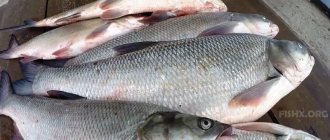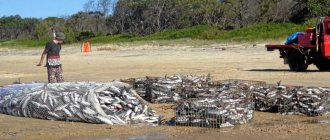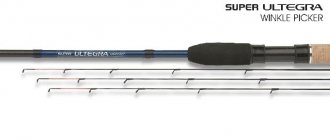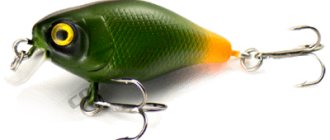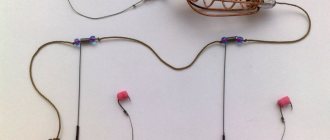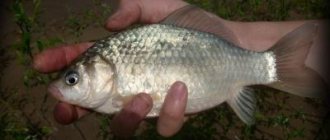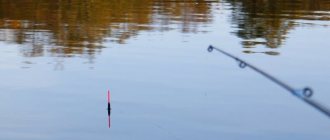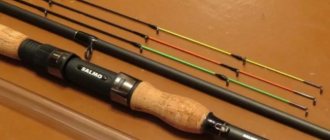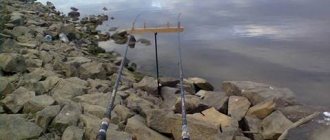Bottom fish can be caught using the lightest gear - a pickerel. But it is often neglected, giving preference to the feeder.
The feeder is used when fishing over long distances. In this case, the bait is done directly at the fishing site. In principle, this is practically a scheme for the operation of the same picker, but only with heavier and more rigid equipment. Technical and tactical techniques for fishing with a picker and a feeder are not much different. But each of them has its own significant features.
Many people do not use pickerel because they have only a superficial understanding of the gear. Others are stopped by the problem of how to make picker tackle with their own hands.
Video training “How to make picker tackle”
Experienced fishermen believe that such an attitude towards lighter gear is unjustified. If only because, in terms of aesthetic pleasure and the effectiveness of quiet hunting, picker gear can be put on a par with others. Moreover, sometimes the result significantly exceeds expectations.
The main purpose of the picker is to catch roach, rudd, crucian carp, white bream and other small fish. Reservoirs where such equipment works best include small ponds and lakes, channels and bays, canals and narrow rivers. Picker gear works most effectively in overgrown banks.
Rod
For pickerel fishing, choose rods designed for equipment from 30 to 50 grams. As a rule, this rod is from 2.1 to 3.3 meters long. More often, a rod with a short handle is used, because when fishing with a pickerel, power casts are not used.
The picker reel is selected based on the main parameter – the balance of the rod and reel.
When using a picker, take the same as when using a feeder - symmetrical and asymmetrical loops, etc. Some fishermen use the Gardner paternoster. The equipment is attractive because its working parts can be quickly replaced; it has proven itself well on any body of water - where there is a strong or weak current, it doesn’t matter. In addition, it takes minimal time to manufacture.
There are fishermen who use equipment with a tubular anti-twist using a spring feeder and a sinker.
Picker feeders
For pickerel fishing, feeders of small volume and light weight are used. But even within the picker limits, the parameters and type must correspond to the specific fishing conditions and the type of intended fish.
Read! Fishing with a feeder on dough
Let’s assume that the main purpose of fishing is bleak or small roach that feed in the water column. In this case, it is worth choosing open-type feeders (mesh) of small mass and preferably plastic. When such feeders are immersed in water, a trail of bait will be created, which will attract fish and force them to sink to the bottom towards the bait table.
The situation is completely different when fishing for bream, carp or any other fish that feeds from the bottom. In this case, closed feeders of greater mass than in the first example are appropriate. On the way to the bottom, they will “lose” a minimum of food and almost all of it will be delivered to the feeding table. At the same time, small fish are minimally attracted to the fishing point, therefore, more respectable specimens can be caught.
When choosing feeders, you should take into account the fishing conditions: depth, presence and strength of current. The principles for choosing feeders are the same as for conventional feeder fishing, but it should be taken into account that in strong currents, fishing with a picker is impossible due to the low carrying capacity of the gear and the weak ability of a light rod to counteract the water flow.
Important factors for success when fishing with pickerel are the maximum delicacy of the tackle, the silent delivery of the bait, because near the shore the fish is careful and it is easier to scare it off than to force it to bite. In this regard, it is recommended to use small feeders that enter the water with minimal noise.
Often when fishing with a pickerel, a sinker is used instead of a feeder. When casting, it creates virtually no noise, and at the bottom it is invisible to the fish and does not frighten it. In this case, a float tactic is used to start feeding balls thrown by hand or using a slingshot. During the fishing process, delicate supplementary feeding is done as necessary to maintain the proper activity of the fish at the point.
Read! Fishing for bream in early autumn on picker
To do this, it is better to prepare two baits: one is more viscous, “long-lasting”, with the addition of soil for casting by hand, the other is “feeder” for delivery in a feeder.
DIY picker tackle
Picker gear is effective in the spring, when the fish are still shy and afraid of loud impacts on the water. The weight dampens such loud impacts on the water as those made, for example, by a feeder with porridge:
- take a weight;
- We pass the fishing line through the eye of the weight;
- fasten the weight: tie a loop;
- we thread the weight through the loop twice;
- tighten the loop: it is important to remember that before tightening the knot, it must be moistened with water;
- make a figure eight or some other loop on the free edge of the fishing line: twist both separate loops of the figure eight, place one loop inside the other and tighten;
- cut off the tail remaining after tying the figure-eight loop;
- from the knot that was made at the very beginning when attaching the weight, we measure approximately 20-25 centimeters in the other direction of the fishing line;
- From this edge we knit the same loop in a figure eight, tighten the loops and cut off the excess edge.
The picker tackle is ready. It is a fishing line with loops at both ends, inside of which there is a weight on a large loop. At one end we tie a leash with hooks to the loop, and at the other - the main fishing line.
Now you can go to the pond to fish. It may be small, but it’s a lot!
obvi.ru
Pros and cons of catching crucian carp with pickerel
Picker , when used for catching crucian carp, has a number of advantages over other gear:
- Longer casting compared to a float rod - a small feeder will not sail when casting, allowing you to easily make accurate casts over a medium distance - up to several tens of meters - .
- The possibility of fishing in strong winds - a float swaying during the wave does not allow you to notice a neat crucian bite , and the light tip of a picker rod will perfectly signal a bite .
- Possibility of baiting fish exactly at the casting point .
- The compact rod allows you to fish even in relatively hard-to-reach places - where a fly -float or feeder rod will cling to branches, with a picker .
makes her cast relatively silent, what's not so scary captured specimens crucian carp - in the end it's reduces time between bites.
Lightness of tackle- The sensitivity of the picker allows you to react even to a cautious crucian bite.
But the picker also has certain disadvantages:
- Due to the lightness of the tackle, when catching a trophy specimen of crucian carp, skill will be required in order to preserve the tackle and not break the thin fishing line .
- Picker is not suitable for long-distance due to the same lightness of the equipment.
catch crucian carp with this tackle from the very beginning of spring , when crucian carp become active until late autumn , excluding the spawning period, when the fish stays near the coastal zone in shallow water.
Also, the characteristics of the picker imply daytime fishing for crucian carp - although it is most active in the early morning and before evening twilight, this tackle allows you to find fish after it has left the feeding grounds to depth . It often happens that a resting crucian carp is tempted by a bait that falls in front of his nose .
Features of autumn fishing

From mid-September until late autumn, the most reliable places for me in terms of fishing with an English bottom rod are shallow river basins bordering river holes. Bream, silver bream and white-eye feed here until late autumn. These fish are schooling fish, and if they go out to feed, the bite is guaranteed to be excellent. And the fishing pressure in these places is minimal. With incomprehensible stubbornness, until late autumn, many anglers continue to fish dumps along river bends, although bream appears here less and less in the fall.
Since the current in river irrigation is not strong and the depth is shallow, a pickerel may be a very good choice. At first glance, this tackle seems too elegant for a large river. Of course, the picker is not designed for ultra-long casts, and you won’t be able to force catch large fish with it. However, the picker has such advantages that one can only dream of with a heavy feeder. One of them is the ability to work in confined spaces. In fact, bushes hanging over the water and thick grass behind the angler are a serious obstacle to the feeder. And with the help of a short picker, with a wave from under your hand, you can easily throw the feeder at a distance of 15 m from you. So for catching bream in the fall in hard-to-reach (and therefore rarely visited by other fishermen) places, pickerel is the most convenient tackle.
Read! Catching burbot
Another advantage of the picker is the ability to work with small, sometimes thimble-sized, wire feeders. With their help, you can deliver only tiny portions of food to the fish, which is a very good solution for the autumn season. When the water is cold or the weather changes suddenly, the fish's appetite becomes sluggish and it is very easy to overfeed them.
But sometimes even such a small feeder turns out to be too noisy for the fish. And in order not to scare away a feeding bream from the shore, instead I put a small flat sinker weighing 10-30 g. This technique works especially well in cases where feeding can be done by hand. At the beginning of fishing, when there is plenty of food on the bottom, and the fish have not yet tasted the treat and are cautious, the noise from the feeder falling into the water can scare away the school. Unlike a feeder, the sinker does not need to be rethrown every 3-5 minutes. Then, when the fish tastes the food, the feeder works better than the sinker. Regular supplementary feeding with tiny portions of bait further whets her appetite.
In order not to overfeed capricious autumn fish, it is better to use very small feeders.
Any reel will do, but no more than 2500 according to the Shimano classification. The main thing is that the friction brake works softly, because during autumn fishing you often have to work in the dark with thin fishing lines.
As the main line, I always use monofilament line no thicker than 0.16 mm. Its tensile strength goes well with the power of a picker rod. If you use a thicker line, your casting distance will noticeably decrease. And the risk of breaking the quivertype greatly increases when the equipment is released while it is hooked on the bottom. For leashes when fishing for bream with pickerel in the fall, I always choose high-quality, preferably fluorocarbon, fishing line with a diameter of 0.1-0.14 mm. The power of modern fishing lines of this diameter is quite enough to easily bring to the surface a fish weighing up to 2 kg. The main requirement for picker hooks is impeccable sharpness of the sting. All other qualities - size, hook shape and wire thickness - are selected based on the angler’s personal preferences, the size of the bait and fishing conditions. It is pointless to give any specific advice on choosing a particular model. Each angler can list several models of hooks that he likes. In my arsenal for autumn pickerel fishing there are hooks No. 10-18. So, if the fish is very capricious and the size of the bait matters to it, I put one or two maggots on hook No. 18. If the bite is good and bream comes up for bait, then I use a red dung worm attached to hook No. 10 as bait.
Read! Fishing with a feeder in a strong current
I prefer to tie rigs for catching bream with pickerel directly on the pond and do not make any home preparations. For many years now I have been using two mounting schemes: a symmetrical loop about 50 cm long and a rig with a sliding sinker, which I simply put on the main fishing line and secure from below through a bead with a swivel. I tie a leash to the swivel. Its length depends on the activity of the fish and ranges from 0.3-1 m. Usually I start fishing with the longest leash, and then, if the fish is active, I gradually shorten it. In the fall, a very useful part of the rig is a fluorocarbon shock leader 5-6 m long. It is especially good in the second half of autumn, when the water becomes especially clear.
How does a picker for crucian carp differ from a feeder?
The structure of the feeder and picker is in many ways similar , but there are also differences between these two gears:
- A picker rod has three parts - two legs and a top, while a feeder rod consists of three legs and a top.
- A picker rod is lighter than a feeder rod, allowing the use of thinner line , ideal for catching medium-sized .
- If when fishing on a feeder you need to constantly use a feeder , then picker fishing is possible without it after the crucian carp is baited in a certain place - to load the tackle, you can use a lead weight that is quieter when casting .
Selecting components for picker gear for crucian carp fishing
To complete picker gear, a rod with a length of 2.4 to 2.7 m , however, when fishing among trees hanging over the water, you can use a two-meter rod .
If you plan to fish
with a long cast , it is better to take a rod 3 m , better with a fast or medium-fast action to be able to quickly make a hook when biting and bring out the crucian carp when fishing in the thickets .
The choice of tip is very important for the correct adjustment of the tackle, since it is the one that serves as indicator - for catching crucian carp in reservoirs with standing water it is better to use soft plastic options, but when fishing in rivers with fast currents, are more suitable .
The standard reel for picker tackle is a lightweight, inertia-free reel with a sufficiently large gear ratio for more active fishing. You can use a light feeder or match reel - the latter are good at laying thin line.
Most often, monofilament with a diameter of 0.12-0.18 mm is used picker tackle , but this will be a reasonable solution only when fishing at short and medium distances .
When casting long distances, the sensitivity of gear using monofilament drops due to its fairly high elasticity, so with this option it is better to use braid. Also, the use of braided fishing line will be justified when fishing for crucian carp among thickets of vegetation. Braid for picker tackle should be taken with a diameter of 0.08 to 0.1 mm .
Feeders for picker gear are light, weighing approximately 15-20 g , most often spiral-shaped. After the fish has been fed, especially when fishing for crucian carp at close distances , the feeder can be replaced with a light lead weight .
A leash for picker tackle is used up to 50 cm . braided for it , as the number of overlaps - it is better to use monofilament.
It is better to choose hooks on the size of the crucian carp in the pond, as well as the bait - for animal baits or sandwiches using baits of animal and plant origin, it is better to use hooks with a long shank , but for vegetable baits, carp hooks with a short shank are better suited.
Fishing for bream on pickerel in spring
As the water warms up, the river comes to life. Full of caviar, the fish rushes to spawn at full speed. My favorite fishing object at this time is bream. Right up to spawning, it is caught in the river very successfully; rough males in breeding plumage are often caught. At this time, it is best to fish not in holes, as at the beginning of winter, but in well-warmed shallow waters.
Of course, I have in mind several proven places where you can catch big fish at this time. But due to their great popularity on weekends, fishing enthusiasts line up there in the evening. This time I didn’t want to catch shoulder to shoulder; the sunny spring day was more conducive to solitude and contemplation. In general, I decided to explore a new and completely unfamiliar section of the lower Moscow River. I've been staring at it for a long time, driving past in my car...
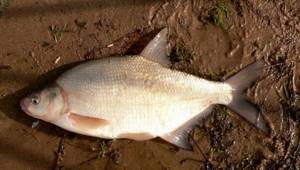
Arriving at the site early in the morning, I was happy to note that there were no competitors in sight. But only a few spinners were wandering around the shore, within sight. A steep, steep bank at a bend in the river indicated the presence of a good hole here with a reverse flow and a rapid at the exit from it.
I went down to the water. The first step is to conduct reconnaissance in unfamiliar terrain. As expected, the hole was at the very bend in the river. The bank above it was steep and earthen - it was inconvenient to fish from it. But downstream behind the hole, an extensive shallow stretch began, the bottom of which was clearly visible in clear weather. Immediately beyond the reach, the shore jutted out slightly into the water with a small cape, behind it was a small pit with a reverse current, and then a flat section of the shore with a convenient fishing area. Flyers were sticking out of the water near the shore, which means that someone is still fishing here with donkeys and float gear.
In general, you should try it. I'm starting to set up my workspace. On such trips “for the soul” I don’t take a lot of fishing belongings with me. There is no need to carry a bulky sports platform - I am quite comfortable fishing while sitting on a regular folding chair. I attach a small module to the tripod, into which I insert four plastic containers in which a supply of small bloodworms is stored, as well as fishing items in the form of spare feeders, dips and attractants for bait. I place the feeder form on a single stand with a soft stand screwed to it. I just stick it near the shore. There is a bucket of bait underfoot. This equipment can be assembled and disassembled after fishing in a matter of minutes.
Now sounding the depths and studying the fishing sector. To begin with, I assemble a fairly powerful rod with a length of 12.4 feet (375 cm) with a test weight of up to 100 g. I equip it with a large reel with a 0.22 mm monofilament wound on the spool. I knit a sliding rig directly on the main line, and between the loop of the main line and the leash I put a rubber shock absorber to soften the jerks of the fish. Knowing how capricious the bite of bream, and other fish, can be, I set myself up for fishing with the thinnest leashes and tiny hooks. To avoid unnecessary breaks, I need additional elasticity between the leash and the main line.
Read: Winter bream fishing on a feeder
Before you start fishing, you need to decide on the distance. I hook on the marker sinker and make the first test cast. There is a crazy current in the middle of the river, I definitely won’t fish there. I reel it in and cast it again, closer to the shore, and it’s blowing again! As a result, I start sounding the depth at a distance of only 20-25 m from the shore. But a sinker weighing 90 g falls to the bottom in an instant, making it clear that it is very shallow here, no more than 2 m. Is it worth fishing here and what kind of fish can you count on?
I drag the sinker along the bottom: dense clay with rare inclusions of stones. I cast a little to the left, a little to the right - there is a clean clay field everywhere, on which there is no point in fishing. Well, maybe he should pack up and go “into the crowd”, to a proven place? But the flyers stuck into the shore force you not to rush, but to try. I decide to fish at a distance where I feel comfortable. Instead of a sinker, I use a metal feeder weighing 80 g. Casting 15 m, the feeder confidently holds the bottom. Trying is not torture, I’ll try to catch at least something!
I mixed the bait in the evening. Its composition is quite simple: one packet of PELICAN “Bream-Vanilla”, 300 g of ground roasted hemp, 500 g of copra-molasses and a little brown paint. The bait turned out to be soft, crumbly and light brown. On the shore I notice that I got the color right, it matches the color of the bottom at the fishing spot - at least it’s some kind of joy!
When fishing in such a strong current, there is no point in starting feeding: no matter how much you feed, everything will be washed away and carried away by the water flow. I start fishing right away with a leash 120 cm long, 0.08 mm thick and a hook No. 18. I hook 3 large bloodworms, add a generous pinch of small larvae to the feeder and make the first cast.
I decide for myself that I will not reload often, about once every 3-5 minutes. I place the rod on the stand and, to be honest, without much hope, I fix my eyes on the tip. After a couple of minutes, it suddenly swayed slightly, and then smoothly bent. Hook, and I understand that there is a very large fish on the other end. I begin to carefully lift it from the bottom. The rubber shock absorber allows me to behave quite harshly with it, preventing it from going downstream. A short struggle and the yellow side of the bream appears on the surface. I never expected such a turn of events. Out of excitement I can’t free the hook from the fish’s lip. I re-attach three bloodworms and throw out the tackle.
Read: Ready bait
We didn't have to wait long. Two minutes later there was a smooth bend again and another bream, a copy of the first, in my cage. It felt like I was in the very center of a bream den. But, upon reflection, I understand that bream cannot stay so close to the shore and at such a shallow depth - I just ended up on the path along which it climbs to its spawning grounds. But it’s very inconvenient to catch with such a long “stick” at a short distance. I decide to change the heavy tackle to a lighter and more comfortable one.
And yet, it’s not for nothing that I take not one, but several rods with me to unfamiliar places. In addition to what I have in my hands now, in the case there is also a feeder 420 cm long with a dough of up to 140 g, another 360 cm long with a dough of up to 60 g, and a picker (light feeder) only 300 cm long and a dough of up to 30 g. That’s exactly what I’ll try to work with now.
A picker rod is a universal tackle: it can be used equally successfully to fish both in closed reservoirs and on rivers with moderate currents. Undoubtedly, its main purpose is to catch small fish at a short distance, up to 30 m. You get real pleasure when you pull out roach, bleak, small chub or dace with such medium-sized tackle.
But my favorite fishing with light pickerel gear is fishing for crucian carp in closed reservoirs without a current. Typically, this type of rod has a parabolic action; the entire blank bends at the slightest load from the very tip to the base at the reel seat. How pleasant it is to fight with frisky crucian carp, making jerks right under the bank, now to the left, now to the right! The thin fishing line rings with the weight of the fish, the drag of the reel performs its long melodic trill, and from this magical combination of sounds: splashes, trills of the clutch and the ringing of a stretched fishing line, a real hymn begins to sound inside to the glory of this elegant tackle.
However, if suddenly a bream or other large river fish swims to the feeding point, the pickerel will be able to cope with the unexpected bonus without any problems.
Another obvious advantage of the picker is its relatively short length (from 180 to 300 cm). It is not always possible to place yourself on the shore in a clear place - you often have to fish under the crowns of trees and bushes hanging over the water, where a short rod is very appropriate.
But in order to warn the reader against disappointment and damage to fishing equipment, I want to dwell in more detail on the structure of picker rods, because some of them can be used in the current, while others should be saved for calmer water.
So, picker forms are different. There are parabolic ones, there are progressive ones (the greater the load, the more the blank starts working), and there are also “fast sticks”, in which only the upper third bends. The latter, as a rule, are made of cheap carbon fiber, have a thick butt and a lot of weight. Their price is usually low, as is their quality.
Read: Effective do-it-yourself bait for large bream
With a progressive picker, you can fish not only on reservoirs without current, but also on rivers with quite decent draft. Naturally, you need to select the weight of the feeders in accordance with the stated test. Although most fishing rods of this type have a certain margin of safety.
With parabolic pickers, you can fish exclusively in closed, stagnant reservoirs, or in small canals or rivers where the current is very weak. There is no point in overloading such forms, and there is no point - they will hardly throw more than the weight indicated in the test. The blank of such rods seems to “fail” under load, i.e. it does not have enough rigidity to impart the necessary acceleration to the feeder. It is advisable to equip pickers with reels of sizes from 2000 to 4000 according to the SHIMANO classification.
But let's get back to my fishing. In my case there was a progressive picker with a length of 300 cm and a dough of 30+ g. Considering the minimum casting range - some 10-12 m, I was not afraid to overload the form even with a 60-gram feeder. When assembling, I used the stiffest tip of the three available, with 1 oz (28 g) test and a size 4000 reel with 0.20 mm mono line. Now fishing has become much more comfortable: casting is no longer stressful, and the fight with large bream is more dynamic and spectacular.
The bream, a large one at that, weighing more than 1 kg, bit regularly. We didn’t have to wait long for a bite: a rare cast was unsuccessful. How my pickerel bent under the weight of the bronze beauties! Working with thin, elegant tackle is a pleasure.
The sun rose higher and higher, and the transparency of the water became greater. This could not but affect the bite. The bream became more cautious, and more and more often its place on the hook began to be occupied by the white-eye, which has a mating plumage in the form of rough spines on its head, and roach. To provoke the bream to bite again, I had to use a thinner leash. The first to occupy are the white-eye, which has a mating plumage in the form of rough spikes on its head, and the roach. To provoke the bream to bite again, I had to use a thinner leash. At first 0.07 mm, and at the end of fishing and 0.06 mm. Thanks to the rubber insert, I didn’t lose a single fish while fishing.
Five hours of fishing was enough for me. Bream were splashing in the fish tank, and a tan appeared on my face. The body received its portion of adrenaline. It was one of the best days I've ever spent fishing. And an important component of this pleasure was the use of light gear that met the fishing conditions. So in the spring and on a serious river there will be work for the picker!
Subscribe to
our Yandex channel Zen
Fishing for picker
Techniques and features of catching crucian carp with pickerel
When fishing with a picker, after familiarizing yourself with the bottom topography and determining the fishing location, you should select a suitable landmark on the other side of the reservoir for the correct casting direction.
It is worth noting the length of the fishing line with a clip - this will allow you to cast exactly to one place , which is very important when feeding fish, since casts during picker fishing should be made at least every 15 minutes when the bite is sluggish. On average, gear is transferred every 5-10 minutes , so using more than three rods is irrational, even with rare bites.
After casting, you need to let the feeder or weight sink to the bottom , and then wind the line so that the quiver tip remains in a bent position - this will allow you to see the bite whenever the crucian carp touches the bait.
Feeding
To feed fish, you can use either a feeder on a picker tackle or formed balls of bait mixture , which are thrown by hand - in the latter case, a lead weight .
Just like catching crucian carp with
a pickerel it requires a fairly high activity - the tackle is often re-thrown; when using feeders, you can abandon them after some time, because when fishing in one place the bait that has fallen from the feeder will be enough to feed the fish .
Bite
Self-hooking of crucian carp when fishing with pickerel is an extremely rare occurrence due to the lightness of the gear, so the angler needs to carefully monitor the condition of the rod tip. Twitching of the tip indicates that the crucian carp is trying the bait , but the hook must be done while the tip is pulled. If the crucian carp has stopped biting, you can try to activate the bite with a small tightening of the tackle - as a rule, moving the bait increases the crucian carp’s interest in it.
Sometimes the crucian carp is reluctant to take the bait and is capricious - after several twitches of the rod tip, it leaves the bait unattended. Often in this case, replacing the hooks with smaller ones and using even thinner leashes helps.
Fishing
When fishing for small and medium-sized specimens of crucian carp, it is best to quickly move them away from the thickets in order to prevent the tackle from snagging, but with trophy specimens you should be more careful - since the picker uses a thin fishing line, it is better not to force the fishing, but to let the crucian carp get a little tired, and only only then pull it to the shore.
Picker reel
An important element of picker tackle is the reel. When choosing it, you must take into account the correspondence of the mass and balance of the gear as a whole. An excellent balance of gear is achieved by installing a reel of size 3000, but sometimes, when maximum speed is important, when sport fishing on a pickerel , reels of at least 4000 or even 5000 are installed.
When using heavier reels, the center of gravity of the tackle is almost in the hand. In this case, it is more comfortable to work with the rod, since the weight of the blank and equipment is felt less when casting and retrieving.
However, when installing a large reel on the picker, beating may occur on the first ring (closest to the reel seat) when the line is reeled out or overlapped during casting. This problem is solved by replacing this ring with a larger one. The reel must also lay the line on the spool efficiently and have a sensitive drag.
Read! Practice catching roach on a feeder



